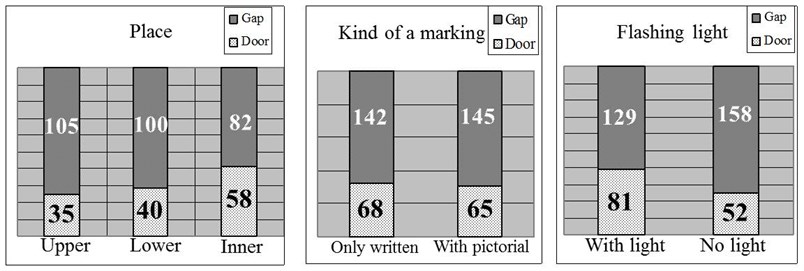Abstract
Manufacturers aim to design electric machines so that users will not get injured if they misuse them. However, manufacturers are not able to consider all types of misuse that may occur. Therefore, an instruction marking that instructs users regarding actions that prevent misuse of the machine in question must be effective, in particular because it is easy to add an instruction marking to a machine. In this study, we have tried to ascertain what types of instruction markings are effective in terms of preventing users from misusing a machine. For a marking to be effective, it may be important that users can easily notice the marking as then they are more likely to heed the related warning. We have carried out experiments on human behavior focusing on the differences in the position of a marking, whether or not a marking includes an illustration, and whether or not a marking has a flashing light in close proximity.
1. Introduction
Most electric machines have moving, vibrating, and, rotating parts such as gears. If people touch these parts, they may be injured by the machines. Therefore, we can say that electric machines have potential safety risks. In order to prevent users from having accidents, manufacturers need to design machines taking safe design and risk assessments into consideration. Today, many manufacturers have tried to design electric machines that do not injure users in the case the users misuse the machines. Moreover, studies on human error have been carried out in order to learn how to systematize patterns of misuse [1-3]. Studies such as these can help machine designers define the intended use of a machine, and identify reasonably foreseeable areas of misuse [4].
However, manufacturers’ attempts to try to reduce safety risks caused by misuse through machine design alone are not the only solution. Many machines carry markings that warn users not to carry out non-standard actions that may lead to safety accidents. Therefore, markings are important for ensuring that a product is used safely. However, users sometimes do not follow manufacturers’ warnings shown on markings and carry out non-standard actions against the manufacturers’ advices. In fact, such cases of misuses sometimes cause product-related accidents. To reduce such product-related safety accidents, it is important to identify and understand instruction markings users tend to follow.
Thus, we have tried to gain an understanding of patterns of markings that users tend to follow. In this study, we have considered to what degree users tend to follow instruction markings, and how easily users recognize markings. We carried out experiments on human behavior focusing on differences in the position of a marking, whether or not a marking includes an illustration, and whether or not a marking has a flashing light in close proximity. Moreover, we have analyzed a questionnaire about how easily each kind of marking is recognized.
2. Experiments
In this study, we have attempted to learn about the influence of human behavior on several kinds of markings. We examined and observed how subjects took a ball out of a box that carried a marking providing instruction on how to take the ball out. Fig. 1 shows a box we used in the experiments. The box has an opening at the front to enable people to gain access to the inside. There is also a door on the side of the box so that people can open it and gain access to the inside. Therefore, in order to take the ball out of the box, subjects can decide whether to reach inside by putting their hands through an opening, or by opening the side door.
In our experiments, we used two kinds of markings. One is a written marking: “Don’t put your hands through this opening.” The other one is a pictorial marking (Fig. 2). The size of the written marking is 10 mm × 60 mm, and the size of the pictorial marking is 50 mm × 67 mm. In this study, we established three kinds of conditions: marking position, type of marking, and whether or not a marking has a flashing light in close proximity. With regard to the marking position, we have studied human behavior when the marking is on the upper side, lower side, or inner side of an opening. Fig. 3 shows the each marking position used in our experiment. With regard to types of markings, we chose two types: only a written marking, and both written and pictorial markings. With regard to flashing lights, we established two conditions: a red flashing light is near the marking, and, no flashing light is near the marking. Table 1 shows the parameters of these conditions. Based on these parameters, we created 12 marking conditions, and gave a name to each box as shown in Table 2.
Fig. 1A box used in the experiments

Fig. 2A pictorial marking in the experiment

Fig. 3The marking positions used in our experiment: a) upper side of an opening, b) lower side of an opening, c) inner side of an opening

a)

b)

c)
Before carrying out these experiments, subjects took a ball from inside a box several times. These actions helped them to understand that a ball was inside a box and that there was a door on the side of the box that enabled access to the interior of the box. The experiments were conducted in a closed room. During the tests, the subjects could not see one another’s actions. We recorded the behavior of each subject. After each subject took balls, they answered a questionnaire about how easy each kind of marking was to recognize.
Details of the experiments are listed below.
• Seven subjects took part in the experiments.
• All subjects were between the ages of 20 and 25.
• The object was a yellow ball with a diameter of 70 mm.
• The gap of an opening was 75 mm (Fig. 1).
• The opening was located at a height of 515 mm (Fig. 1).
• Five boxes were in the test room. Four had a ball inside, and one did not.
• Subjects were told to take out four balls as quickly as possible.
• Only one subject participated in the experiment at a time.
• No subject could see the others’ behavior during the test.
• Subjects’ behaviors were recorded while they were taking the balls.
• Subjects filled in a questionnaire just after each test.
Table 1Test conditions for human behavior about an instruction marking
Conditions | 1 | 2 | 3 | |
I | Place relative to an opening | Upper side | Lower side | Inner side |
II | Kind of a marking | Only written one | With pictorial one | --- |
III | Red flashing light near a marking | Light | No light | --- |
Table 2Configurations of boxes in each test condition
Box No. | I. Place | II. Kind of a marking | III. Flashing light |
1 | I. Upper | II. Only written one | III. With light |
2 | III. No light | ||
3 | II. With pictorial one | III. With light | |
4 | III. No light | ||
5 | I. Lower | II. Only written one | III. With light |
6 | III. No light | ||
7 | II. With pictorial one | III. With light | |
8 | III. No light | ||
9 | I. Inner | II. Only written one | III. With light |
10 | III. No light | ||
11 | II. With pictorial one | III. With light | |
12 | III. No light |
3. Results
We analyzed the results of subjects’ questionnaires and behaviors while they were taking balls out of twelve kinds of boxes. We have analyzed the results focusing on the three conditions described in Table 1. During the analysis process, we considered the results for boxes Nos. 1 to 4 as ‘a marking is on the upper side of an opening’, the results for boxes Nos. 5 to 8 as ‘a marking is on the lower side of an opening’, and the results for boxes Nos. 9 to 12 as ‘a marking is inner side of an opening’. With regard to the conditions related to the kinds of markings and whether or not there is a flashing light, we analyzed the results in the same way as the way we analyzed marking positions as shown in Table 2.
First, we will discuss the questionnaire results. We analyzed the questionnaire results which seven people answered twice regarding the condition of the 12 kinds of boxes. In the questionnaire, the easier it is for subjects to recognize a marking, the higher the condition’s related points are. The maximum number of points is 5, and the minimum number is 1. Therefore, the more points related to a condition a marking got, the easier the marking is to recognize. Table 3 shows questionnaire results about the different conditions of boxes. From the information on marking positions shown in Table 3, we have found that subjects can recognize a marking on the outside of a box more easily than one on the inner side of a box. And, they can recognize a marking on the upper side of an opening more easily than one on the lower side of an opening. We believe this is because the opening is below eye level. Subjects could easily see the upper side before seeing an opening, and, subjects could see a marking on the upper side of an opening more easily than a marking on the lower side of an opening. From the information on marking types shown in Table 3, we have discovered that subjects are more likely to recognize a marking that features both text and a picture over one that contains text only. Moreover, regarding a flashing light, as seen from Table 3 we have found that subjects were equally able to recognize a marking with a flashing light as they were able to recognize one without a flashing light.
Table 3Questionnaire results about the different conditions of boxes
Questionnaire | Questionnaire | Questionnaire | |||
Upper | 3.36 | Only written | 2.35 | With light | 2.88 |
Lower | 2.66 | With pictorial | 3.26 | No light | 2.73 |
Inner | 2.39 |
Next, we have focused on whether test subjects tried to put their hands through the opening in front of the box to get the ball. These results show whether subjects followed the marking instruction. We have analyzed the results of the experiments which seven people attempted five times of each condition for 12 kinds of boxes. Regarding subjects’ actions, we have also analyzed the results considering the three conditions shown in Table 1. Fig. 4 shows the results of how the subjects took balls out of twelve kinds of boxes. In this study, if a subject took a ball out by opening a side door, it means the subject followed an instruction marking. From Fig. 4, we have found that subjects more often tended to follow a marking that was on the inner side rather than on the outer side of a box. And, regarding types of markings, we have found that subjects tended to follow a written marking instruction and an instruction marking comprised of both text and a picture to an approximately equal degree. Moreover, we have found that subjects tended more often to follow an instruction marking near a flashing light than one in which there was no flashing light.
Fig. 4The results of how the subjects took balls out of each kind of box. Gap: one took a ball from a front opening. Door: one took a ball by opening a side door

4. Discussions
The results of these questionnaires and the results of the actions in our experiments lead us to believe that people do not necessarily tend to follow a marking instruction if they can easily recognize a marking. Based on the questionnaire results, we have concluded that an instruction marking on the inner side of an opening was not recognizable, but based on the results of the experiments we have found that people tended to follow an instruction marking on the inner side. Moreover, the results have shown that a marking instruction near a flashing light was as recognizable as one that was not near a flashing light, however, subjects more often tended to follow a marking instruction near a flashing light than one that was not.
We will discuss these results. In this study, subjects were asked to answer a questionnaire about how easily each kind of marking was able to be recognized. Therefore, the survey results may depend on something that people are conscious of. On the other hand, the results of the experiments show that an instruction marking positioned on the inner side of a box or near a flashing light is effective at making people follow the marking instruction and – in this case – to take a ball out by opening a side door. It can be said that an instruction marking near a flashing light indicates that something is moving. And, people may internally feel that an instruction marking on the inner side of a box is more obvious because they can see the marking while they are putting their hands though an opening. It is possible that the results we have obtained are due to the marking instruction that has a flashing light nearby to catch a user's attention can provide information about a potential instruction to them. Therefore, we have found that an instruction marking that has a flashing light nearby or that moves relative to a person’s action must be effective in order for a person to follow it.
5. Conclusions
In this study, in order to gain an understanding of the influences of human behavior on several kinds of instruction markings, we carried out experiments to ascertain how subjects took a ball out of a box based on a marking that provided instructions on how to do so.
Based on the results of questionnaires and the conclusions drawn from the associated actions, we have found that people do not necessarily tend to follow an instruction marking in cases where they can easily recognize the marking. In particular, we see instances where marking instructions near a flashing light and others that may be more obvious to users internally are not necessarily recognizable, but people still tend to follow the marking instructions. We have found from the results that an instruction marking that moves relative to a person’s action must be very effective in order for a person to follow the relevant instruction.
We need to utilize the effective methods we have discovered from our study in the actual products. It is important that we locate the most effective position to add an instruction marking on each product.
References
-
Lough K. G., Stone R., Tumer I. The risk in early design method. Journal of Engineering Design, Vol. 20(2), 2009, p. 155-173.
-
Yu F.-J., Hwang S.-L., Huang Y.-H., Lee J.-S. Application of human error criticality analysis for improving the initiator assembly process. International Journal of Industrial Ergonomics, Vol. 26, 2000, p. 87-99.
-
Watson M. C., Bond C. M., Johnson M., Mearns K. Using human error theory to explore the supply of nonprescription medicines from community pharmacies. Quality and Safety in Health Care, Vol. 15(4), 2006, p. 244-250.
-
Benedyk R., Minister S. Applying the BeSafe method to product safety evaluation. Applied Ergonomics, Vol. 29(1), 1998, p. 5-13.
